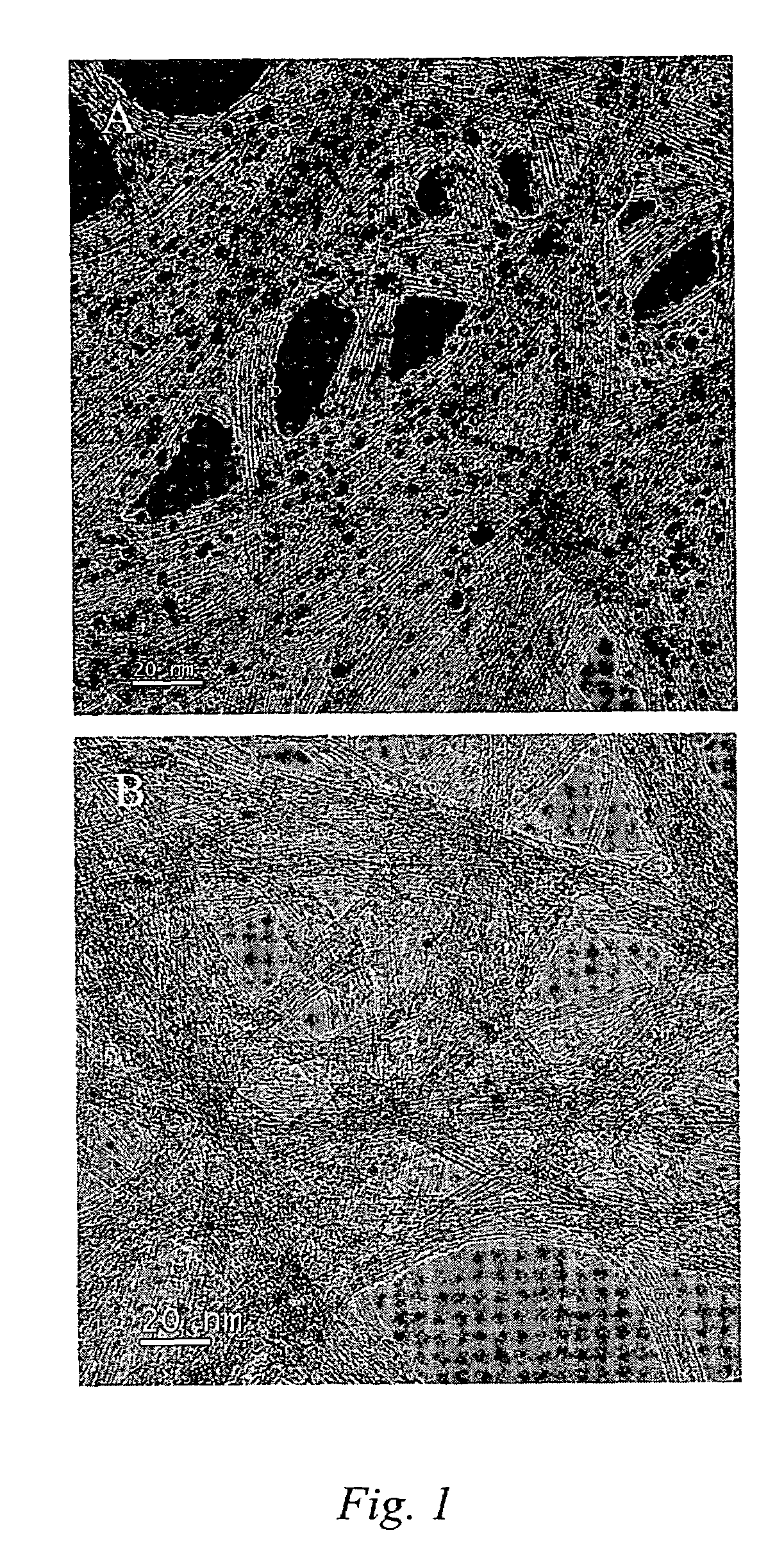Purification of carbon nanotubes based on the chemistry of fenton's reagent
a carbon nanotube and reagent technology, applied in the field of carbon nanotube purification processes, can solve the problems of high cost involved in synthesis and purification, large impurities in the product, and widespread use of carbon nanotubes
- Summary
- Abstract
- Description
- Claims
- Application Information
AI Technical Summary
Benefits of technology
Problems solved by technology
Method used
Image
Examples
example 1
[0037]This example serves to illustrate how iron-containing unpurified CNTs can generally be purified using a one-pot process.
[0038]Water is added to raw CNT material to form a slurry that is heated to 20-80° C. (step 1). The pH of the slurry is adjusted and maintained at between about 1 and about 3 (step 2), and hydrogen peroxide is added to form an oxidative slurry and start the reaction of Fenton's reagent (step 3). The oxidative slurry is stirred for 0.5 to 2 hours (step 4). Phase separation is allowed to occur between the nanotubes and the solution (step 5), after which the slurry is decanted or filtered (step 6). The isolated, purified carbon nanotubes are then washed with acidic water until all exposed metal ions are removed (step 7). If desired, any of steps 1-7 are repeated one or more times.
example 2
[0039]This example illustrates some possible variations on the process described in the previous example.
[0040]The filtration to remove impurities can be automated using a principle similar to Soxhlet extraction. For example, the reaction container can be designed in a manner similar to that of a Soxhlet extractor, such that when the water solution surrounding the CNT sample (enclosed in a filter paper or a porous material) exceeds a certain level, it overflows and trickles back down into the accepting container. Water can be added at a programmed time to trigger the flush of the solution. H2O2, water, and other reactants could be added in a sequential manner to automate the process until the nanotube material is cleaned.
[0041]The purifed nanotubes, while still in water, may convert directly into what is known in the art as “bucky pearls” by adding hexane [Yang et al., U.S. Published Patent Application No. US 2003 / 02153803].
[0042]An iron containing salt (such as, but not limited to ...
example 3
[0045]This example illustrates a particular procedure for the purification of raw HiPco-produced carbon nanotubes employing 4 cycles, 30 minutes each.
[0046]To 40.9 mg of raw HiPco material was added 20 ml of 1N HCl, to form an acidic slurry. This slurry was heated to 60° C. (hot plate) and stirred at 600 rpm. To this heated acidic slurry was added 20 ml H2O2 to form an oxidative slurry that continued to be heated and stirred for 30 minutes. The addition of HCl and H2O2, and subsequent heating and stirrings was repeated (i.e., cycled) three more times, each time allowing the heated oxidative slurry to stir for 30 minutes, and for an additional 60 minutes at 51° C. on the last cycle. Phase separation was allowed to proceed followed by filtering the carbon phase (upper layer on a filter paper) and washing with 1N HCl and nanopure water. The collected sample was dried at 120° C. in air for 2 hours. The purified product weight was 30.1 mg (carbon yield ca. 100%), and thermal gravimetric ...
PUM
| Property | Measurement | Unit |
|---|---|---|
| diameter | aaaaa | aaaaa |
| length | aaaaa | aaaaa |
| temperatures | aaaaa | aaaaa |
Abstract
Description
Claims
Application Information
 Login to View More
Login to View More - R&D
- Intellectual Property
- Life Sciences
- Materials
- Tech Scout
- Unparalleled Data Quality
- Higher Quality Content
- 60% Fewer Hallucinations
Browse by: Latest US Patents, China's latest patents, Technical Efficacy Thesaurus, Application Domain, Technology Topic, Popular Technical Reports.
© 2025 PatSnap. All rights reserved.Legal|Privacy policy|Modern Slavery Act Transparency Statement|Sitemap|About US| Contact US: help@patsnap.com



